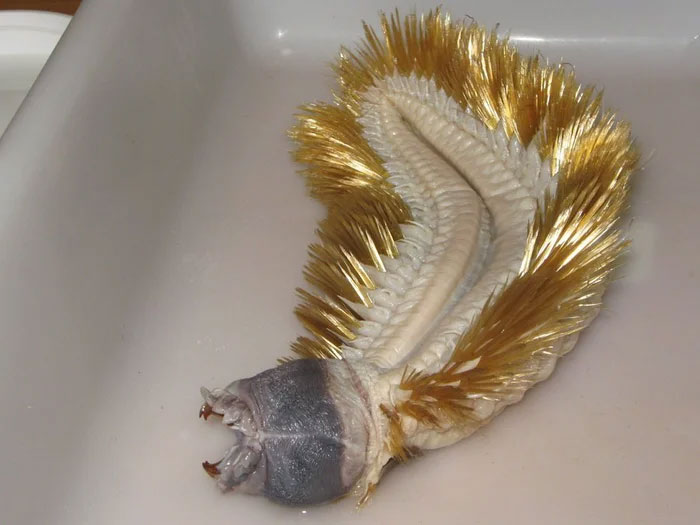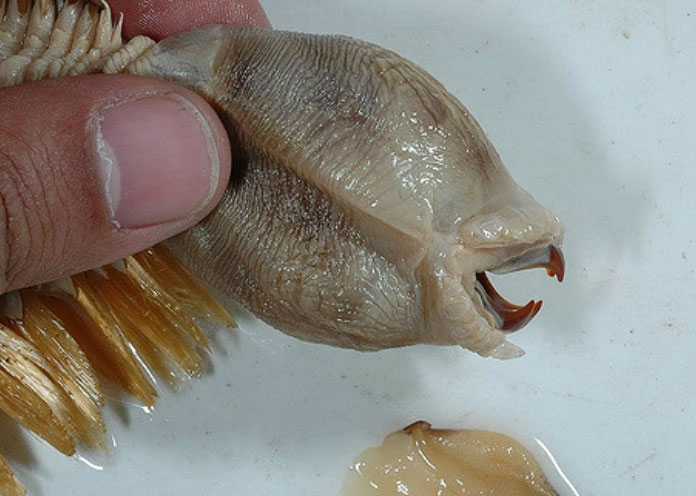Stunned to discover strange, mysterious creatures in Antarctica
This Antarctic creature has an extremely strange appearance, perhaps when many people see them they will definitely think of alien monsters in science fiction movies.
In the vast Southern Ocean of Antarctica, there is a species of giant worm, possessing an extremely strange appearance with many golden hairs that sparkle like metal.
Their scientific name is Eulagisca gigantea , the most prominent feature of this species is its yellow furry belly and its mouth filled with sharp fangs. These features also give them an extremely scary appearance.

Eulagisca gigantea is a polychaete worm of the family Polynoidae, averaging about 12cm in length and found in Antarctica. Its legs look like soft hairs, but if touched, they are poisonous.
As strange as it may seem, recent research suggests that this species may be vital to the health of our planet's ecosystems.
This strange creature is also known as a bristle worm, belonging to the Polychaetes family - which translates to "many small hairs" . They are worms with an average length of about 12cm. And usually live in the Antarctic region.
According to the Monterey Bay Aquarium Research Institute, creatures in the Polychaetes family come in many shapes and sizes, from roundworms the size of candy canes to ones over two meters long — found in a variety of habitats and in a wide range of colors.

The mouth of this worm is only about 2cm wide, but its sharp fangs can easily capture enemies. But until now, no one has given an exact method of hunting, because they live deep in the Antarctic and partly because no one has been brave enough to test it.
In fact, the Eulagisca gigantea worm uses the stiff bristles on its abdomen to move on the ocean floor. At the same time, this is also the "weapon" of this species' defense. That is why this worm has unusual characteristics, and is also rarely studied by science because of its difficult-to-access habitat.
Trichiasis was first discovered in 1939, but we still don't know much about their biology or diet.
However, the size of its long and powerful jaws suggests that it fed on other marine fish. However, information about its diet is still not well understood, and its hunting methods are still a mystery. But the creature's sharp teeth also suggest that it may have been a scavenger.
Additionally, the head-like body part is actually a retractable throat that extends about 5 to 7 cm outward when they feed.

Eulagisca gigantea belongs to the Polynoidae family, which includes many species of short, flat marine worms found all over the world. They are characterized by their body coverings called elytra . Like a true Xenomorph, when feeding, this worm will extend its 7cm long throat and tear apart its prey with its sharp mouth.

To date, scientists have described 80 families and 8,000 different species of marine worms, but the actual number is likely much higher. In fact, researchers have recently used DNA analysis to estimate that the worms may play an important role in ocean ecosystems and could provide scientists with insights into life in the deep ocean.

These scaly sea worms are found in the Antarctic and Southern Oceans. They are greyish-brown in color and have no markings on their bodies. They are found at depths of 40 to 700 meters. Eulagisca gigantea has a flat body and up to 15 pairs of scales on its back.
Eulagisca gigantea worms grow up to 20cm long. These marine creatures have 40 body segments covered by 15 pairs of scales called elytra.
Overall, their heads are oval in shape. They have a tubular proboscis that ends in a pair of large jaws with sharp teeth. The head is about a quarter the size of the rest of the body.
The body and head of this creature are typically grayish-brown in color. Additionally, hundreds of yellow hairs called chaetes extend from its body in tufts on each side along its length.
This creature is usually solitary, except during reproduction. Females attract males by secreting a pheromone that tells males that they are ready to reproduce.
After being released into the water, the female's eggs are fertilized by the male. The fertilized eggs usually float freely in the water as plankton. These eggs develop into larvae. After the larval stage, their bodies grow to adult size.
- Mysterious creatures exist under 740m thick ice in Antarctica
- Finding monsters 'five-finger hands' like people in Antarctica?
- Strange sea creatures in Antarctica
- Glaciers melt to reveal mysterious objects
- Discovering strange sea creatures suspected of being aliens in America
- Detecting concussions about 20 species of strange creatures in Antarctica
- Decode the mysterious circle in Antarctica
- Mysterious decoding of strange ice holes constantly appearing in Antarctica for decades
- Stunned to discover strange sharks in Mexico
- Can a strange Pacific creature save the world?
- Thousands of strange creatures like jellyfish drifted to the California coast
- Discover the mysterious creature in the deepest area of the Indian Ocean
 Animal 'suffering' after hibernation
Animal 'suffering' after hibernation Why do goats climb well?
Why do goats climb well? Scientists were surprised to see chimpanzees eating turtles
Scientists were surprised to see chimpanzees eating turtles Giant catfish died deadly due to drought in Thailand
Giant catfish died deadly due to drought in Thailand